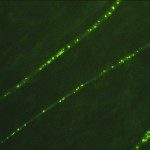Lien vers Pubmed [PMID] – 14585545
Biochimie 2003 Aug;85(8):777-88
Rabies virus (RV) causes a non-lytic infection of neurons leading to a fatal myeloencephalitis in mammals including humans. By comparing the infection of the nervous system of mice by a highly pathogenic neuroinvasive strain of RV (CVS) and by a strain of attenuated pathogenicity (PV) with restricted brain invasion, we showed that RV neuroinvasiveness results of three factors: not only neurotropic RV avoids induced neuron cell death but also “protective” T cells that migrate into the infected nervous system are killed by apoptosis and finally inflammation of the infected nervous system is limited. Our data suggest that the preservation of the neuronal network, the limitation of the inflammation and the destruction of T cells that invade the CNS in response to the infection are crucial events for RV neuroinvasion and for transmission of RV to another animal.

